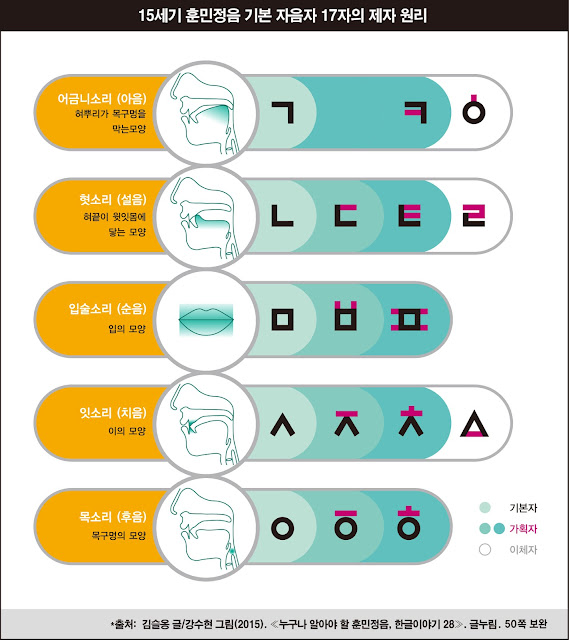한글창제의 원리_자음 창제의 원리 (Principles of Hangul Creation_Principles of Consonant Creation)

The Korean alphabet, Hangul, was developed with a unique principle that relates the shapes of its consonants to the parts of the mouth used to pronounce them.
Here's a detailed explanation in English to help foreigners learn and appreciate the ingenious design behind Hangul:
The consonants in Hangul were initially created to mimic the shape of the mouth and tongue when making their sounds. This makes Hangul highly phonetic and easy to learn.
For instance:
is shaped like the tongue blocking the throat, where the sound originates – this sound is known as "Guttural".
'ㄴ'
resembles the tongue touching the roof of the mouth, thus called a "Lingual" sound.
'ㅁ'
takes the shape of the lips and is called a "Labial" sound.
'ㅅ'
looks like the teeth and produces a sound known as "Dental".
'ㅇ'
represents the shape of the throat and is known as the "Nasal" sound.
These are considered the primary characters (기본자) of Hangul from which other letters are derived.
These are considered the primary characters (기본자) of Hangul from which other letters are derived.
Additional strokes, called "가획" (Gahyeop), are added to these primary characters to form other related consonants.
For example:
Adding an extra stroke to 'ㄱ' creates 'ㅋ', which has a more robust, aspirated sound.
One more stroke to 'ㄷ' turns it into 'ㅌ', which has a more robust, aspirated sound.
One more stroke to 'ㅂ' turns it into 'ㅍ', which has a more robust, aspirated sound.
One more stroke to 'ㅈ' turns it into 'ㅊ', which has a more robust, aspirated sound.
Tense consonants, like 'ㄲ', 'ㄸ', 'ㅃ', 'ㅆ', and 'ㅉ', are formed by writing the basic consonants, such as 'ㄱ', 'ㄷ', 'ㅂ', 'ㅅ', and 'ㅈ', twice side by side.
Tense consonants, like 'ㄲ', 'ㄸ', 'ㅃ', 'ㅆ', and 'ㅉ', are formed by writing the basic consonants, such as 'ㄱ', 'ㄷ', 'ㅂ', 'ㅅ', and 'ㅈ', twice side by side.
ㄱ → ㄲ
ㄷ → ㄸ
ㅂ → ㅃ
ㅅ → ㅆ
ㅈ → ㅉ
'ㄱ' (g/k sound):
It’s shaped after the position of the tongue blocking the throat, producing a sound from deep in the throat—called a "Guttural" sound.
'ㄴ' (n sound):
This character mimics the tongue touching the roof of the mouth, making a "Lingual" sound.
'ㅁ' (m sound):
This block resembles the closed lips, making a "Labial" sound.
'ㅅ' (s sound):
It’s shaped after the teeth and makes a "Dental" sound.
'ㅇ' (ng sound):
It symbolizes the throat, producing a "Nasal" sound.
These shapes are the foundation of Hangul consonants. To create more sounds, extra strokes—called 가획 (Gahyeop)—are added:
These shapes are the foundation of Hangul consonants. To create more sounds, extra strokes—called 가획 (Gahyeop)—are added:
'ㄱ' with an extra stroke becomes 'ㅋ' (k' sound), a more robust, breathy version of 'ㄱ'.
Add a stroke to 'ㄷ' (d/t sound), and you get 'ㅌ' (t' sound), a more forceful version of 'ㄷ'.
'ㅂ' (b/p sound) with an additional stroke turns into 'ㅍ' (p' sound), an aspirated version of 'ㅂ'.
'ㅈ' (j sound) gains a stroke to become 'ㅊ' (ch sound), a sharper, more pronounced version of 'ㅈ'.
'ㄱ' becomes 'ㄲ' for a tenser 'g/k' sound.
'ㄷ' becomes 'ㄸ' for a tenser 'd/t' sound.
'ㅂ' becomes 'ㅃ' for a tenser 'b/p' sound.
'ㅅ' becomes 'ㅆ' for a tenser 's' sound.
'ㅈ' becomes 'ㅉ' for a tenser 'j' sound.
These principles show how Hangul closely ties the shape of the letters to the physical act of speaking, making it a logical and intuitive system for beginners.
These principles show how Hangul closely ties the shape of the letters to the physical act of speaking, making it a logical and intuitive system for beginners.


Comments
Post a Comment